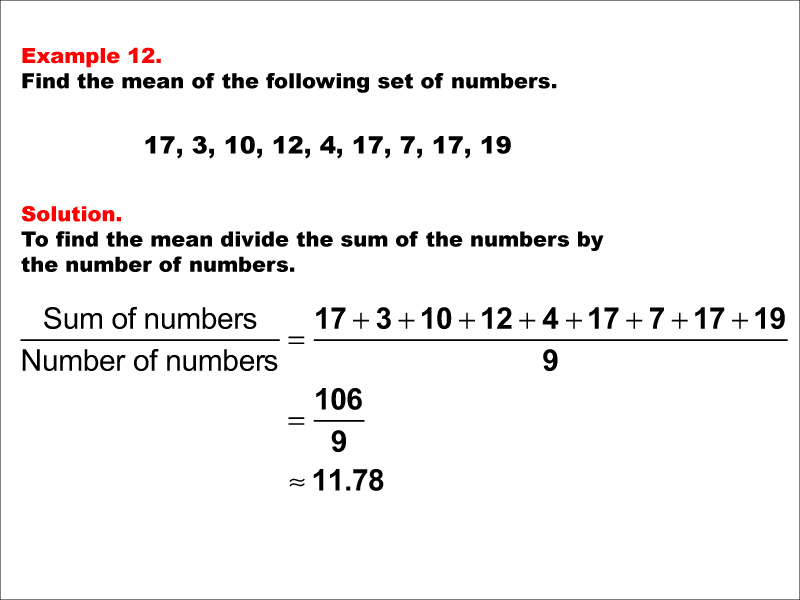
Display Title
Math Example--Measures of Central Tendency--Mean: Example 12
Display Title
Math Example--Measures of Central Tendency--Mean: Example 12

Topic
Measures of Central Tendency
Description
This example demonstrates the calculation of the mean for the numbers 17, 3, 10, 12, 4, 17, 7, 17, and 19. The process involves summing all values (106) and dividing by the count of numbers (9), resulting in a mean of approximately 11.78. This example showcases how the mean can provide a representative value for a dataset that includes repeated numbers and a wide range of values.
Understanding measures of central tendency, particularly the mean, is crucial in statistics and data analysis. These measures provide a way to summarize large amounts of data into a single, representative value, allowing for quick comparisons and insights. Mastering these concepts enables students to interpret data effectively, make informed decisions, and prepare for more advanced statistical analyses in various fields of study.
The presentation of multiple examples is key to solidifying students' grasp of the mean concept. Each new example, while following the same basic process, presents a unique set of numbers. This repetition with variation helps students recognize the underlying principles and develop the flexibility to apply the concept across diverse situations. It also builds confidence in their ability to handle different types of datasets they might encounter in academic research or real-world problem-solving scenarios.
Teacher Script: "We've reached our twelfth example of calculating the mean. Take a moment to observe the range of numbers in this dataset, from 3 to 19, with 17 appearing three times. As we solve this problem, think about how this spread of values and the repetition might affect our final result. How does our calculated mean of approximately 11.78 relate to the individual numbers in the set? Remember, the mean gives us a 'balance point' for our data, but it doesn't always correspond to any single value in our dataset. This example illustrates how the mean can effectively represent a dataset even when it includes repeated values and a wide range of numbers."
For a complete collection of math examples related to Measures of Central Tendency click on this link: Math Examples: Measures of Central Tendency: Mean Collection.
| Common Core Standards | CCSS.MATH.CONTENT.6.SP.B.4, CCSS.MATH.CONTENT.6.SP.A.3, CCSS.MATH.CONTENT.HSS.ID.A.2, CCSS.MATH.CONTENT.HSS.ID.A.3 |
|---|---|
| Grade Range | 6 - 12 |
| Curriculum Nodes |
Algebra • Probability and Data Analysis • Data Analysis |
| Copyright Year | 2014 |
| Keywords | data analysis, tutorials, measures of central tendency, mean, average |